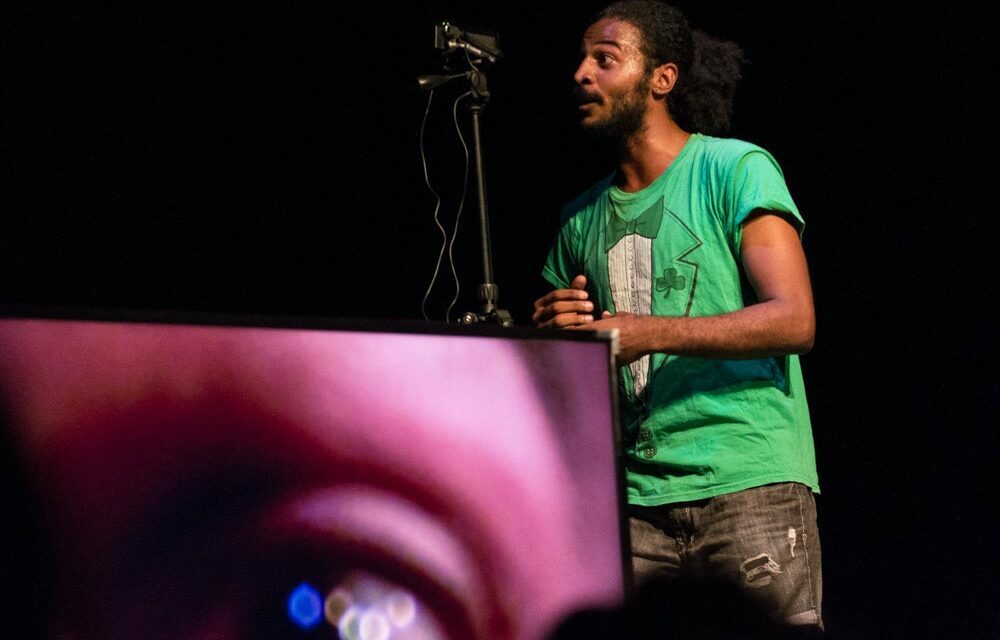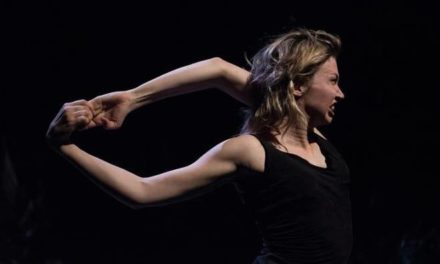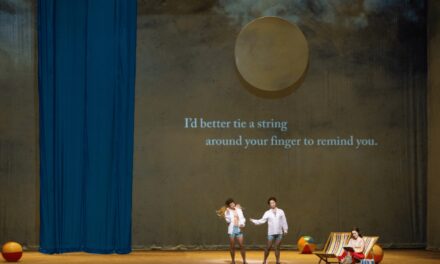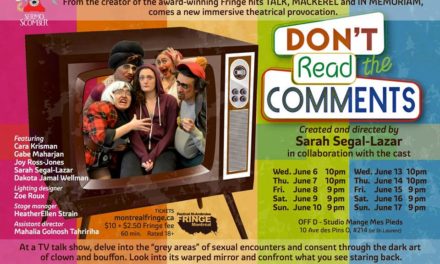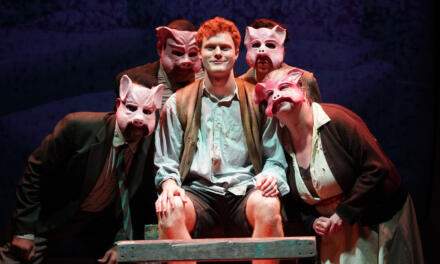Art Babayants is a performer and the Artistic Director of the Toronto Laboratory Theatre, working with casts of people who all speak several languages and who are interested in normalizing a linguistic landscape that presents this form of diversity.
We saw an exciting sample of their work in the context of a theatre research symposium, entitled Mediating Performance Experiences: Cultures and Technologies in Conversation which took place at the University of Ottawa directed by Dr Yana Meerzon, specialist in questions of theatre and immigration in Canada, as well as migration and multilingualism in European Theatre. As a sample of this form of performance experience, she brought in this extremely interesting and highly challenging group of young people plus three surprise local guests with others from Montréal.
It might have sounded overly ambitious at first, but the audience rapidly became an integral part of all these multimedial encounters. Images projected on a screen were used to dismantle the bodies as linguistic communication was dismantled for those listening and where the protagonists as well as those in the audience search for the meanings being transmitted. It was an exciting puzzle, figuring out how to hear the relationship between one of the official languages and the unfamiliar language or even the other persons form of corporeal expression, using facial expressions picked up o the screen, or other forms, or other ways of transmitting meaning that appeared to alienate the bodies from each other. Languages and their cultural references are so terribly complex that we sometimes wonder how we manage to communicate with people and why there are not more wars, and violence, given the frustration of not always being able to express everything in the exact detail that we would wish.
Some might feel terribly uncomfortable, some might not be able to follow, some might be highly stimulated by this challenge, but these differences are the basis of the research that Toronto, theatre Laboratory is investigating, apparently taking us back to the era of Theatre laboratories in the 1960s, 70s, etc. with Jerzy Grotowski, Richard Schechner, Julian Beck, Peter Brook, the Bread and Puppet theatre. This sends us back to the work of the most innovative forms of corporal creativity in the performance space at that period. Theatre was inspired by anti-naturalistic non western forms of ritual, thanks to the discovery of Artaud ‘s interest in the Balinese dancer, which was published in English at the end of the 1960s, but seriously misunderstood at that time by most people and by Artaud himself, in an attempt to transform the actors, apparently manipulated by an invisible superior force. Thus they thought they could inspire change in western culture which was in the process of destroying humanity with the war in Viet Nam.
Nothing quite as romantic is taking place in the confines of this new Toronto laboratory and it is not at all concerned with ritual theatre although it does have in mind a certain form of psychic transformation that could help us all. However, Babayants is working on a practical and almost lighthearted form of interaction in the body-centred “ empty space”, developing performance theories that could very well transform human relations in our country and teach all Canadians a more positive way of interacting with the masses of new citizens flowing through our big cities, seeking new forms of communication, interactive habits and corporeal signs associated with languages that we do not recognize. Guidance is needed to help people capture these new sounds, these new gestures, or these new linguistic patterns that seem to have no apparent relation to the ones that have always dominated our lives in Canada…English or /and French. What a strange new multi-lingual world!!!
Lasting over an hour, it progresses as a series of brief skits, sometimes spontaneous, sometimes written, more than often devised – drawn from personal experience or already existing dramaturgy – that involve quick exchanges, where everyone will probably understand at least one language. They come to an end quickly before the audience even realizes what has taken place, the spectator is again whisked away to another atmosphere where more things are about to take place until one’s head is in a great whirl of meaning as the situations accumulate, as links between these situations begin to appear and cracks start to open in the basic structure of our absolutely solid, unbreachable cultural certitudes.
No preaching, nothing of that sort, just simple playful moments that become exceedingly obvious to any of us who can think on our own.
First moment, two young women running…jogging, in an exercise class.
One: Tell me something.
Two: Yes?
One: Where do you really come from?
Two: Ottawa
One: ..but before?
Two: Kanata….
One: but where do your “people” come from.. (embarrassed silence)…the girl # 2 leaves. Does not even like the question in our post-nationalist world
Other skits work in more subtle ways. The Portuguese speaker describes a football game as someone with well defined corporeal tools transmits all the portions of the game that help the audience find meaning. Who gets the goals, who misses the goals. Who are the favorite teams. The excitement is easily communicated. Then Gao arrives, with her gestures of a timid young girl who is supposed to represent those Chinese girls living in Canada who have maintained traditional gestures in spite of the Canadian contact whereas we now see how Canadian girls who try to imitate Chinese women in certain circumstances using similar gestures become absolutely ridiculous by transforming the gestures into an almost clown-like experience because they have lost the delicate nuances that define the Chinese origins of those gestures.
Also, what lacks here is the difference between the two forms of Chinese, Mandarin and Cantonese which are also cultural markers of Chinese immigrants that are notable in Canada since the majority of immigrants from Hong Cong speak Cantonese but those of us who do not know that have no way of recognizing those differences and these questions do not appear in the work the Laboratory is doing. It will perhaps come at a later time.
What about stereotypes tacked on Arabic speakers like Ahmed, the ‘terrorist’ from Iraq, who is trying out for a role that others think he couldn’t do, because it does not fit into his physical stereotype. The playful and almost spontaneous reactions of self-derision in other difficult situations bring about linguistic solutions which deflate the tension and cause laughter when the participants don’t get it and then realize how silly they have been.
However, it works beautifully when different people with associated linguistic skills in the audience do catch on. Thus the director has great pleasure in hearing short outbursts of laughter around the theatre as comparable speakers located in different parts of the audience get the jokes whereas the others do not. Suddenly there is a sense of being connected within the group, as different groups catch on to different words in various places of the audience space as the recognition takes effect!!!.
All through the performance, Art, the director/pianist is at his electric keyboard, listening, watching and playing a stimulating piece of music, suggesting mysterious rhythms that hype up the energy and suddenly connect us all to the music, which in itself becomes a strong, independent voice carrying the group forward in that intimate space.
The skits take on various kinds of communication challenges, but the participants are never insulted or frustrated and the audience is riveted to the acting space trying to ‘get’ it all until there is a final lyrical outpouring of tender verse in many languages at a point where the tonal distinctions reflect emotions that words are no longer needed to express. This soon becomes a complete cacophony of many voices, talking loudly in all their languages at one time, ignoring the others, carried away by a post-modern buzz of collective humanity that goes beyond all feelings of embarrassment, of self-consciousness, of shyness, and the show comes to a glorious end. Then, the whole audience moves spontaneously onto the stage, anxious to meet these actors themselves, not their stage personae, to find out more about the individuals and less about the characters until the stage manager comes to tell us that the actors have to eat and get ready for the next show. And we have to leave the theatre. But we linger on, in spite of ourselves, already an integral part of the event which no longer seems challenging or problematic. A magnificent learning experience of intense human communication!!
It must come back to Ottawa!!
Created by the group, directed by Art Babayants who is also the pianist.
Typer Kruspe, the producer based in Toronto, has studied Theatre and Architecture at the U of Toronto, and Urban studies from Simon Fraser U. in Vancouver. He has worked with Touchstone theatre and the TooBA physical Theatre ensemble.
Performers
Ahmed Moneka: Iraqui theatre artist. has worked in theatre film, in Bagdad, makes his home in Toronto. Speaks Arabic, English, French
Art Babayants: origin Armenian, has a doctorate in theatre performance, he taught acting in the theatre department of the University of Regina. His research emphasizes multilingual theatre in Canada and he has staged multiple musical performances
Gloria Gao: Toronto based come to Toronto from China in 2011. Theatre and performance studies at the U of Toronto, She is fluent in Mandarin, Cantonese, and English
Mario Lourenco Graduate of the Conservatory of Theatre in Portugal teaches theatre arts of the clown and gestalt therapy workshops
Moriana Kachmarsky. Studied theatre at the U of Ottawa, interested in collective creation, immersive and interactive theatre. She speaks English and Ukranian
Ludmylla Mar Dos Reis: MFA in directing from the U of Ottawa. speaks Brazilian, Portuguese and English
Nabila Hadibi: From Algiers, MA in computer science. She speaks English, French, and Tamazight (in Algeria)
This article was originally posted on www.captialcriticscircle.com on May 14, 2019. Reposted with permission. Read the original article here.
This post was written by the author in their personal capacity.The opinions expressed in this article are the author’s own and do not reflect the view of The Theatre Times, their staff or collaborators.
This post was written by Alvina Ruprecht.
The views expressed here belong to the author and do not necessarily reflect our views and opinions.

